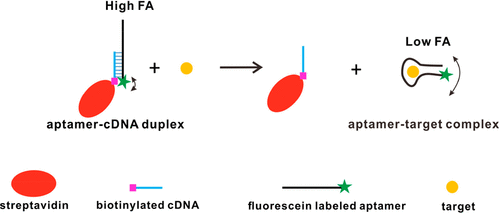当前位置:
X-MOL 学术
›
Anal. Chem.
›
论文详情
Our official English website, www.x-mol.net, welcomes your
feedback! (Note: you will need to create a separate account there.)
Aptamer Structure Switch Fluorescence Anisotropy Assay for Small Molecules Using Streptavidin as an Effective Signal Amplifier Based on Proximity Effect.
Analytical Chemistry ( IF 6.7 ) Pub Date : 2019-05-13 00:00:00 , DOI: 10.1021/acs.analchem.9b01253 Yapiao Li 1, 2 , Qiang Zhao 1, 2
Analytical Chemistry ( IF 6.7 ) Pub Date : 2019-05-13 00:00:00 , DOI: 10.1021/acs.analchem.9b01253 Yapiao Li 1, 2 , Qiang Zhao 1, 2
Affiliation

|
Fluorescence polarization/anisotropy (FP/FA) approaches are appealing for targets sensing in homogeneous solution due to simplicity, reproducibility and sensitivity. Taking advantage of aptamers, aptamer structure switch FA methods are unique for small molecule detection based on the competition between aptamer-target binding and the hybridization of aptamer and complementary DNA (cDNA). However, usually small FA change is generated in these aptamer assays that only rely on size change caused by hybridization of an oligonucleotide because of the rapid local rotation of fluorophores and small mass change. Here we describe a simple and general aptamer structure switch FA assay for small molecules by employing a large-sized streptavidin (SA) as an effective signal amplifier based on proximity effect to reduce local rotation of fluorophore. In this design, the SA-labeled cDNA hybridizes with fluorescein (FAM)-labeled aptamer, drawing FAM close to SA and bringing a much higher FA value due to restricted local rotation of FAM. Small molecule-aptamer probe binding causes displacement of the SA-labeled cDNA and great decrease of FA. The closeness of SA to FAM in the duplex is key for this proposed strategy to produce large FA changes in target detection. Our method enabled to detect 60 pM aflatoxin B1 (AFB1), 1 nM ochratoxin A (OTA), and 0.5 μM adenosine triphosphate (ATP), respectively. This aptamer FA method combines the merits of aptamers and FA analysis, and it is promising in applications of detection of small molecules with good sensitivity.
中文翻译:

基于接近效应,使用链霉亲和素作为有效信号放大器,对小分子进行适体结构转换荧光各向异性测定。
荧光偏振/各向异性(FP / FA)方法因其简单性,可重复性和灵敏度而吸引了均质溶液中的目标物。利用适体,适体结构转换FA方法基于适体-靶标结合与适体和互补DNA(cDNA)杂交之间的竞争,对于小分子检测是独特的。然而,由于荧光团的快速局部旋转和小的质量变化,在这些适体测定中通常仅依靠由寡核苷酸杂交引起的大小变化产生小的FA变化。在这里,我们通过使用大型链霉亲和素(SA)作为有效的信号放大器,基于邻近效应来减少荧光团的局部旋转,描述了一种用于小分子的简单且通用的适体结构开关FA测定法。在这种设计中,SA标记的cDNA与荧光素(FAM)标记的适体杂交,使FAM接近SA,并由于FAM的局部旋转受限而带来更高的FA值。小分子-适体探针结合导致SA标记cDNA的置换和FA的大量减少。SA与FAM在双工中的接近性是此提议的在目标检测中产生较大FA变化的策略的关键。我们的方法能够分别检测60 pM黄曲霉毒素B1(AFB1),1 nM ra曲霉毒素A(OTA)和0.5μM三磷酸腺苷(ATP)。该适体FA方法结合了适体和FA分析的优点,在灵敏度高的小分子检测应用中很有前途。使FAM接近SA并由于FAM局部旋转受限而带来更高的FA值。小分子-适体探针的结合导致SA标记的cDNA的置换和FA的大大减少。SA与FAM在双工中的接近性是此提议的在目标检测中产生较大FA变化的策略的关键。我们的方法能够分别检测60 pM黄曲霉毒素B1(AFB1),1 nM ra曲霉毒素A(OTA)和0.5μM三磷酸腺苷(ATP)。这种适体FA方法结合了适体和FA分析的优点,在具有良好灵敏度的小分子检测应用中很有前途。使FAM接近SA并由于FAM局部旋转受限而带来更高的FA值。小分子-适体探针的结合导致SA标记的cDNA的置换和FA的大大减少。SA与FAM在双工中的接近性是此提议的在目标检测中产生较大FA变化的策略的关键。我们的方法能够分别检测60 pM黄曲霉毒素B1(AFB1),1 nM ra曲霉毒素A(OTA)和0.5μM三磷酸腺苷(ATP)。这种适体FA方法结合了适体和FA分析的优点,在具有良好灵敏度的小分子检测应用中很有前途。SA与FAM在双工中的接近性是此提议的在目标检测中产生较大FA变化的策略的关键。我们的方法能够分别检测60 pM黄曲霉毒素B1(AFB1),1 nM ra曲霉毒素A(OTA)和0.5μM三磷酸腺苷(ATP)。这种适体FA方法结合了适体和FA分析的优点,在具有良好灵敏度的小分子检测应用中很有前途。SA与FAM在双工中的接近性是此提议的在目标检测中产生较大FA变化的策略的关键。我们的方法能够分别检测60 pM黄曲霉毒素B1(AFB1),1 nM ra曲霉毒素A(OTA)和0.5μM三磷酸腺苷(ATP)。这种适体FA方法结合了适体和FA分析的优点,在具有良好灵敏度的小分子检测应用中很有前途。
更新日期:2019-05-13
中文翻译:

基于接近效应,使用链霉亲和素作为有效信号放大器,对小分子进行适体结构转换荧光各向异性测定。
荧光偏振/各向异性(FP / FA)方法因其简单性,可重复性和灵敏度而吸引了均质溶液中的目标物。利用适体,适体结构转换FA方法基于适体-靶标结合与适体和互补DNA(cDNA)杂交之间的竞争,对于小分子检测是独特的。然而,由于荧光团的快速局部旋转和小的质量变化,在这些适体测定中通常仅依靠由寡核苷酸杂交引起的大小变化产生小的FA变化。在这里,我们通过使用大型链霉亲和素(SA)作为有效的信号放大器,基于邻近效应来减少荧光团的局部旋转,描述了一种用于小分子的简单且通用的适体结构开关FA测定法。在这种设计中,SA标记的cDNA与荧光素(FAM)标记的适体杂交,使FAM接近SA,并由于FAM的局部旋转受限而带来更高的FA值。小分子-适体探针结合导致SA标记cDNA的置换和FA的大量减少。SA与FAM在双工中的接近性是此提议的在目标检测中产生较大FA变化的策略的关键。我们的方法能够分别检测60 pM黄曲霉毒素B1(AFB1),1 nM ra曲霉毒素A(OTA)和0.5μM三磷酸腺苷(ATP)。该适体FA方法结合了适体和FA分析的优点,在灵敏度高的小分子检测应用中很有前途。使FAM接近SA并由于FAM局部旋转受限而带来更高的FA值。小分子-适体探针的结合导致SA标记的cDNA的置换和FA的大大减少。SA与FAM在双工中的接近性是此提议的在目标检测中产生较大FA变化的策略的关键。我们的方法能够分别检测60 pM黄曲霉毒素B1(AFB1),1 nM ra曲霉毒素A(OTA)和0.5μM三磷酸腺苷(ATP)。这种适体FA方法结合了适体和FA分析的优点,在具有良好灵敏度的小分子检测应用中很有前途。使FAM接近SA并由于FAM局部旋转受限而带来更高的FA值。小分子-适体探针的结合导致SA标记的cDNA的置换和FA的大大减少。SA与FAM在双工中的接近性是此提议的在目标检测中产生较大FA变化的策略的关键。我们的方法能够分别检测60 pM黄曲霉毒素B1(AFB1),1 nM ra曲霉毒素A(OTA)和0.5μM三磷酸腺苷(ATP)。这种适体FA方法结合了适体和FA分析的优点,在具有良好灵敏度的小分子检测应用中很有前途。SA与FAM在双工中的接近性是此提议的在目标检测中产生较大FA变化的策略的关键。我们的方法能够分别检测60 pM黄曲霉毒素B1(AFB1),1 nM ra曲霉毒素A(OTA)和0.5μM三磷酸腺苷(ATP)。这种适体FA方法结合了适体和FA分析的优点,在具有良好灵敏度的小分子检测应用中很有前途。SA与FAM在双工中的接近性是此提议的在目标检测中产生较大FA变化的策略的关键。我们的方法能够分别检测60 pM黄曲霉毒素B1(AFB1),1 nM ra曲霉毒素A(OTA)和0.5μM三磷酸腺苷(ATP)。这种适体FA方法结合了适体和FA分析的优点,在具有良好灵敏度的小分子检测应用中很有前途。













































 京公网安备 11010802027423号
京公网安备 11010802027423号